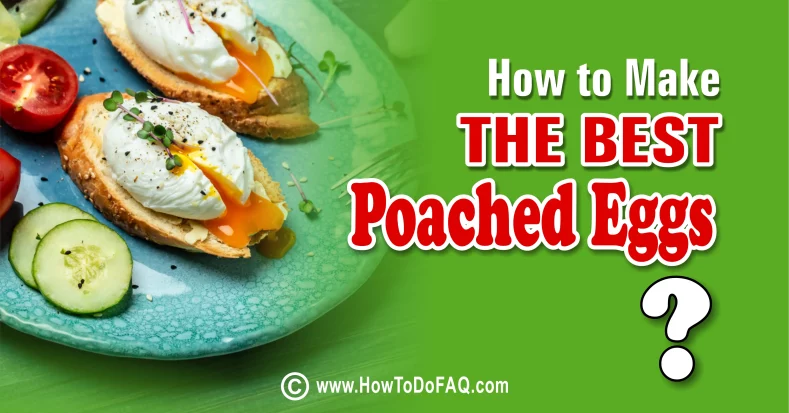A Step-by-Step Guide to Making the Best Poached Eggs
Poached eggs are an epic flavor that everyone enjoys with their brittle texture and rich taste. Unlike boiled eggs, which are cooked in their shells, poached eggs are delicately cooked shell-less in simmering water. Hence the egg’s whites are delicate and velvety while the yolk is runny and thicker than boiled eggs. They are best used for breakfast, brunch or as a topping for salads and other dishes. How to make the best poached eggs?
A ideal and the best poached egg can be judged by just a few features. First, will be the yolk, which should remain absolutely smooth and whole. Next the jelly-like egg should not have solidified, the bottom will certainly cook more quickly, yet the yolk will become thicker, although the structure will remain whole. The better the egg whites and yolk look to the whole short, the more reliably the process has been completed. Follow these simple guidelines and conjure up a poached egg that is guaranteed to impress any manner of breakfast or brunch guest you may be serving.
What is a Poached Egg?
Poached eggs, tender and rich in composition, are an epicurean delight for everyone. This egg is cooked without its shell, as opposed to a boiled egg, cooked within its shell. What is it? The white and egg white are ideally soft for the best flavor: the oval in shape has a runny center and a slightly thicker inner wall. The egg white will cook and the oval will thicken slightly. When you see this, you’re all set. You’ll have produced something that looks a lot like a traditional oval on the whole egg.
Difference from Boiled Eggs:
The main “difference” is – boiled eggs are more hard while poached eggs are light and soft. The egg white and yolk, which are gently cooked, are runnier so the egg is oval in shape when cooked.
How to Make the Best Poached Eggs:
Making the Best Poached Eggs is simple and stationed method. The following is a step-by-step guide to making these eggs:
- Prepare a pot of water: Fill a sauce with water. To prepare, fill a large pot with water, and heat it over medium heat until it simmers slightly. The water will be hot to the touch, but not boiling sharply. The container should be shallow and wide, because if you decide to try to make your eggs poached perfectly, without any devices, at home, you should take care to gently lower the egg into a wide, shallow dish filled with such simmering water. Water (or whatever liquid you decide to use) should not fill the dishes completely. The container must hold about 1.5 liters or be about 10 cm in depth. If you wish to use milk instead of water, go ahead.
- Add vinegar (optional): Pour one or two tablespoons of vinegar into the boiling water, this will help the egg whites to protein faster. However, this step is optional, so if you don’t like the taste of vinegar or something, just skip it.
- Crack the eggs: To make it easier to slide the eggs into the water, first break each one into a small bowl or saucer. After all, if you choose to break the yolk when you crack the egg, everything you could do to poach an egg may not work.
- Create a gentle whirlpool: Now, we need a whirlpool. Take a spoon or spatula and create a swirl in the water by stirring. This rotation will help the protein to wrap around the yolk. The vortex prevents the egg white from disintegrating into tassels and ensures that it remains as a whole mass.
- Then slide the egg from the bowl into the water in the center of this whirlpool. However, since when moving an egg from a bowl to a container, the egg breaks, some people prefer to pour it directly without any steps out, but pour one by one slowly. In addition, having broken the eggs into the container simultaneously, their proteins will also fatten more slowly; due to the fact that we first broke the eggs into a cup and then poured it from there into the water and, plus, constantly stir it with a spoon or spatula, the container will break it into its small and neat protein frame!..
.
To help keep up the state of the egg, twirl around it in a roundabout movement. A seasoning technique to encompass the yolk with the white, shaping it like this for around 20 seconds or until the white sets. Hold up for 3-5 minutes until cooked. You will realize that the egg is cooked when the whites are set, and the yolks start to thicken. - Cook to desired doneness: Allow the egg to cook undisturbed for about 3-4 minutes for a soft, runny yolk, or longer for a firmer yolk. Turn down the tenderly bubbling water to a stew. The water ought to be scarcely stewing and the temperature around 160-180ºF (71-82ºC). Ensure that you don’t drop the egg into bubbling water (100ºC/212ºF), as this will toughen the eggs and make them unpalatable. Now, use a slotted spoon to gently lift the poached egg from the water and drain any excess water.
.
Work rapidly to move each egg onto the plate, letting an abundance of water trickle once more into the dish. Larousse Gastronomique encourages invigorating the egg in chilly water and afterward channeling it on a piece of fabric. Culinary specialist Michael Romano prescribes dunking the eggs into stewing, salted water for 30 seconds and putting them on a dry tea towel to dry. - Serve immediately: Poached eggs are best served immediately while they are still warm and the yolk is runny. Season with salt and pepper to taste if desired.
■++



